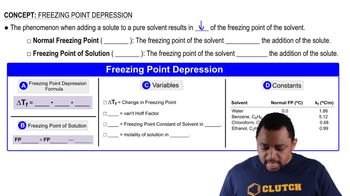Here are the essential concepts you must grasp in order to answer the question correctly.
Osmotic Pressure
Osmotic pressure is the pressure required to prevent the flow of solvent into a solution through a semipermeable membrane. It is directly proportional to the molarity of the solute and can be calculated using the formula π = iCRT, where π is the osmotic pressure, i is the van 't Hoff factor (which is 1 for non-dissociating compounds), C is the molarity, R is the ideal gas constant, and T is the temperature in Kelvin.
Recommended video:
Freezing Point Depression
Freezing point depression is a colligative property that describes the lowering of the freezing point of a solvent when a solute is added. The extent of freezing point depression can be calculated using the formula ΔTf = iKf m, where ΔTf is the change in freezing point, Kf is the freezing point depression constant of the solvent, and m is the molality of the solution. This concept is essential for determining the molar mass of the solute.
Recommended video:
Freezing Point Depression
Molar Mass Calculation
Molar mass is the mass of one mole of a substance, typically expressed in grams per mole (g/mol). To find the molar mass of a solute from colligative properties, one can rearrange the formulas for osmotic pressure or freezing point depression to solve for molar mass, using the measured values of osmotic pressure, freezing point change, and the properties of the solvent. This calculation is crucial for identifying the molecular weight of the organic compound in the question.
Recommended video:
Molar Mass Calculation Example




